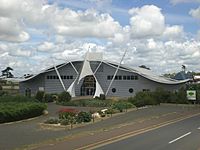Dinosaur Isle facts for kids

The outside of Dinosaur Isle
|
|
| Established | 2001 |
|---|---|
| Location | Sandown, Isle of Wight |
| Type | Paleontological |
| Visitors | 60,000+ |
Dinosaur Isle is a super cool museum all about dinosaurs! You can find it in Sandown, a town on the Isle of Wight in southern England. Imagine a building shaped like a giant flying reptile – that's Dinosaur Isle! It was designed by an architect named Rainey Petrie Johns. This museum is special because it was the first one in Europe built just for dinosaurs.
Contents
Discovering Dinosaurs: A Look at History
Early Finds on the Isle of Wight
For a long time, people on the Isle of Wight have been finding amazing dinosaur fossils. In the 1800s, many fossil hunters, like the Reverend William Fox, dug up new types of dinosaurs. Some of these included Aristosuchus, Hypsilophodon foxii, and Polacanthus.
Most of these incredible finds were sent away to other places for study. This made the Isle of Wight Council decide to start its own collection. They wanted to keep these important fossils close to home.
The First Museum and Dinosaur Isle's Opening
The Isle of Wight's very first museum about geology opened in Sandown in 1923. It was called the "Museum of Isle of Wight Geology."
Years later, the new Dinosaur Isle museum was built. It cost about £2.7 million. This money came from the Isle of Wight Council and the National Lottery Millennium Commission. Dinosaur Isle opened its doors to visitors on August 10, 2001.
Today, the museum holds over 40,000 fossil pieces. It has nearly 200 "type specimens," which are the first fossils used to describe a new species. The museum also offers exciting field trips. You can go with experts to explore the island's best fossil sites.
What You Can See: Exploring the Exhibits
Journey Through Time: Past Ecosystems
Your visit to Dinosaur Isle starts with a journey through different ancient environments. You'll see fossils from the Pleistocene era, including bones from ancient bison called Bison antiquus. There's also a repaired animatronic of an Ophthalmosaurus. This amazing model came from the BBC show Walking with Dinosaurs.
As you move through the museum, you'll discover the first animals from the Mesozoic Era. This is the time when dinosaurs lived! You'll see exhibits about ancient sea creatures. A large sauropod model is displayed at the very end of this section.
The Main Dinosaur Hall
The biggest room in the museum is all about dinosaurs. Here, you'll find many life-size models and replicas. You can see plant-eating dinosaurs like Iguanodon, Polacanthus, and Hypsilophodon. There are also meat-eating dinosaurs, such as Eotyrannus.
A huge Neovenator salerii is also on display. This large meat-eater was found in 1978. It was described by Steve Hutt, one of the museum's curators. You can also see a replica skeleton of Megalosaurus.
Special Skeletons and Flying Reptiles
One of the most special skeletons is Iguanodon MIWG.5126, also known as "Pink Iggy." It was discovered in 1976 by Steve Hutt. Most of its bones were found together, just as they were when the dinosaur died. It's called Pink Iggy because of the pink minerals in the rocks where it was found. The museum also displays the first fossil of a small crocodile-like creature called Koumpiodontosuchus.
Look up at one of the walls in the main room. You'll see models of different pterosaur heads. These were flying reptiles that lived with dinosaurs. The museum even has the first fossil of a pterosaur called Caulkicephalus.
Meet the Experts
At Dinosaur Isle, you can actually talk to the paleontologists who work there. These are the scientists who study fossils. You might even get to watch them as they work on new discoveries!
Images for kids
See Also
- Dinosaurs of the Isle of Wight








